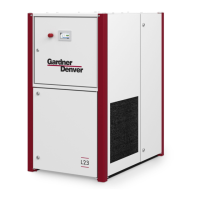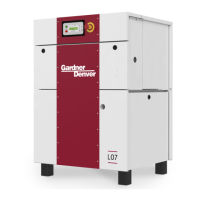Do you have a question about the Gardner Denver L90 and is the answer not in the manual?
Covers prohibitions like breathing compressed air and operating with open doors.
Directs users to observe safety regulations in Section 4 of the manual.
Emphasizes reading the manual, using trained staff, and ensuring legible notices.
Details dangers like high-pressure air, flying parts, connection risks, and hot/expanding lines.
Addresses risks from high temperatures, strong suction, and unexpected tool startup.
Warns about inhaling compressed air and pressure relief valve safety.
Covers risks of electric shock, poor power quality, and unexpected remote starts.
Warns about legionella growth in open cooling towers.
Covers risks of parts falling, incorrect lifting, and damage to components.
Highlights dangers from worn components, perished lines, and oil spurts.
Covers risks from faulty electrical equipment and system integrity.
Stresses the need for trained technicians and using correct spare parts.
Details risks of electric shock from condensers and unexpected startups.
Covers safety during maintenance, securing systems, and depressurizing components.
Warns against unauthorized modifications and their effect on safety equipment.
Provides safety guidelines for lifting and transporting the compressor unit.
Details requirements for levelling the unit and maintaining clearance for maintenance.
Warns about defective connections and specifies requirements for safe hookup.
Warns about fire risks and specifies requirements for power supply and wiring.
Details risks from charged capacitors and earthing requirements for IT networks.
Step-by-step guide to checking the oil level, including safety precautions.
Emphasizes safety checks for rotating parts and casing closure.
Lists steps like checking oil level, terminals, water supply, and power.
Explains how to check and correct the rotation direction of motors and fans.
Outlines checks for oil level, valves, water supply, and power for routine commissioning.
Advises not to repeatedly switch on after malfunction without rectification.
Explains the function and proper use of the emergency stop button.
Highlights dangers of high voltage, charged capacitors, and residual pressure.
Provides a comprehensive schedule of maintenance tasks and their frequencies.
Details safety measures for shutting down, depressurizing, and handling oil.
Step-by-step guide for replacing the oil filter cartridge, including safety.
Warns about explosive pressure release and outlines testing procedures.
Covers prohibitions like breathing compressed air and operating with open doors.
Directs users to observe safety regulations in Section 4 of the manual.
Emphasizes reading the manual, using trained staff, and ensuring legible notices.
Details dangers like high-pressure air, flying parts, connection risks, and hot/expanding lines.
Addresses risks from high temperatures, strong suction, and unexpected tool startup.
Warns about inhaling compressed air and pressure relief valve safety.
Covers risks of electric shock, poor power quality, and unexpected remote starts.
Warns about legionella growth in open cooling towers.
Covers risks of parts falling, incorrect lifting, and damage to components.
Highlights dangers from worn components, perished lines, and oil spurts.
Covers risks from faulty electrical equipment and system integrity.
Stresses the need for trained technicians and using correct spare parts.
Details risks of electric shock from condensers and unexpected startups.
Covers safety during maintenance, securing systems, and depressurizing components.
Warns against unauthorized modifications and their effect on safety equipment.
Provides safety guidelines for lifting and transporting the compressor unit.
Details requirements for levelling the unit and maintaining clearance for maintenance.
Warns about defective connections and specifies requirements for safe hookup.
Warns about fire risks and specifies requirements for power supply and wiring.
Details risks from charged capacitors and earthing requirements for IT networks.
Step-by-step guide to checking the oil level, including safety precautions.
Emphasizes safety checks for rotating parts and casing closure.
Lists steps like checking oil level, terminals, water supply, and power.
Explains how to check and correct the rotation direction of motors and fans.
Outlines checks for oil level, valves, water supply, and power for routine commissioning.
Advises not to repeatedly switch on after malfunction without rectification.
Explains the function and proper use of the emergency stop button.
Highlights dangers of high voltage, charged capacitors, and residual pressure.
Provides a comprehensive schedule of maintenance tasks and their frequencies.
Details safety measures for shutting down, depressurizing, and handling oil.
Step-by-step guide for replacing the oil filter cartridge, including safety.
Warns about explosive pressure release and outlines testing procedures.
| Brand | Gardner Denver |
|---|---|
| Model | L90 |
| Category | Air Compressor |
| Language | English |











